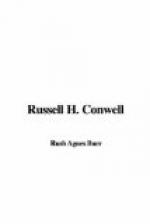I remember we had a Peace Jubilee here in Philadelphia soon after the Spanish war. Perhaps some of those visitors think we should not have had it until now in Philadelphia, and as the great procession was going up Broad street I was told that the tally-ho coach stopped right in front of my house, and on the coach was Hobson, and all the people threw up their hats and swung their handkerchiefs, and shouted “Hurrah for Hobson!” I would have yelled too, because he deserves much more of his country than he has ever received. But suppose I go into the High School to-morrow and ask, “Boys, who sunk the Merrimac?” If they answer me “Hobson,” they tell me seven-eighths of a lie—seven-eighths of a lie, because there were eight men who sunk the Merrimac. The other seven men, by virtue of their position, were continually exposed to the Spanish fire, while Hobson, as an officer, might reasonably be behind the smoke-stack. Why, my friends, in this intelligent audience gathered here to-night I do not believe I could find a single person that can name the other seven men who were with Hobson. Why do we teach history in that way? We ought to teach that however humble the station a man may occupy, if he does his full duty in his place, he is just as much entitled to the American peopled honor as is a king upon a throne. We do teach it as a mother did her little boy in Now York when he said, “Mamma, what great building is that?” “That is General Grant’s tomb.” “Who was General Grant?” “He was the man who put down the rebellion.” Is that the way to teach history?
Do you think we would have gained a victory if it had depended on General Grant alone? Oh, no. Then why is there a tomb on the Hudson at all? Why, not simply because General Grant was personally a great man himself, but that tomb is there because he was a representative man and represented two hundred thousand men who went down to death for their nation and many of them as great as General Grant. That is why that beautiful tomb stands on the heights over the Hudson.
I remember an incident that will illustrate this, the only one that I can give to-night. I am ashamed of it, but I don’t dare leave it out. I close my eyes now; I look back through the years to 1863; I can see my native town in the Berkshire Hills, I can see that cattle-show ground filled with people; I can see the church there and the town hall crowded, and hear bands playing, and see flags flying and handkerchiefs steaming—well do I recall at this moment that day. The people had turned out to receive a company of soldiers, and that company came marching up on the Common. They had served out one term in the Civil War and had re-enlisted, and they were being received by their native townsmen. I was but a boy, but I was captain of that company, puffed out with pride on that day—why, a cambric needle would have burst me all to pieces. As I marched on the Common at the head of my company, there was not a man more proud than I. We marched




